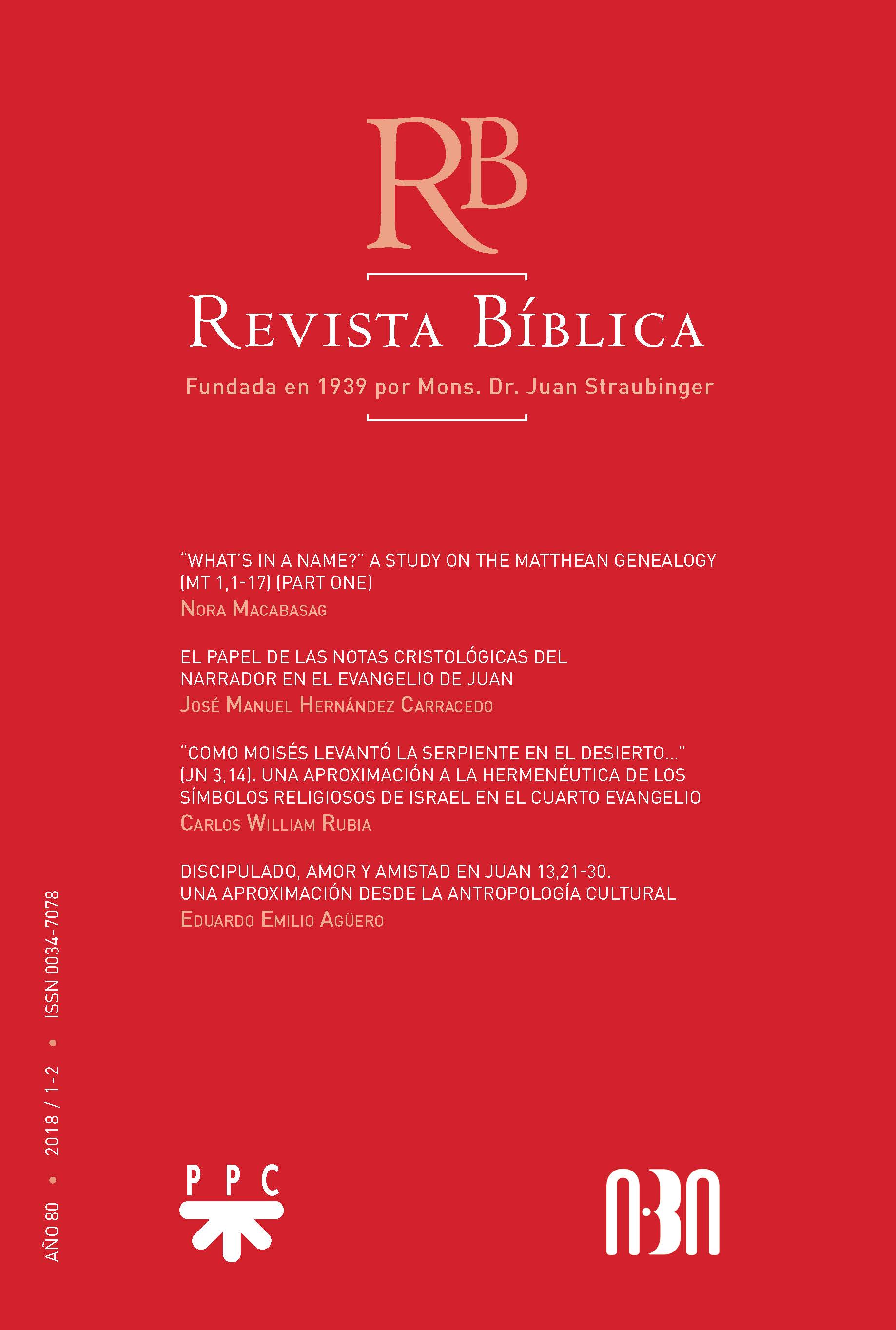Discipleship, Love, and Friendship in John 13:21-31
An Approach through Cultural Anthropology
DOI:
https://doi.org/10.47182/rb.80.n-201818Keywords:
Anthropology, Cultural models. , Cultural keys, Master, Disciples, Honour, Shame, Status, Dyadic contract, Love, Friendship, Community, Secreto, Revelation, MediationAbstract
Cultural anthropology helps to approach the biblical text by unravelling certain cultural keys to understand the Master-disciple relationship in the New Testament socio-cultural context. The community aspect acquires a fundamental value in the fourth Gospel. Friendship with the Master also includes the veneratio of the latter. The status within the community is linked to the degree of intimacy of each disciple with their Master, which in turn is measured with the level of confidentiality that exists between them. Just as Jesus has the role of mediator, the disciples are also the mediators of Jesus, witnesses of the love they themselves had experienced.
References
Beasley-Murray, G. R., John (World Biblical Commentary 36), Nashville 1999.
Beutler, J., Judaism and the Jews in the Gospel of John (Studia Biblica 30), Roma 2006.
Brown, R. E., The Churches the Apostles left Behind, New York 1984.
–, An Introduction to the Gospel of John (Anchor Bible 2), New York 2003.
Byrne, B. J., “The Faith of the Beloved Disciple and the Community in John 20”, JSNT 23 (1985) 8397.
Carminati, G. P., “‘Non vi chiamo più servi, ma amici’ (Gv 15,13). La communione come effeto della rivelazione dell’amore”, PSV 70 (2014) 141163.
Charlier, J.P., Jesús en medio de su pueblo. III. Calendario litúrgico y ritmo de vida, Bilbao 1993.
ClarkSoles, J., “Of Footwashing and History”, en P. N. Anderson – F. Just – T. Thatcher (eds.), John, Jesus, and History. Aspects of Historicity in the Fourth Gospel 2, Atlanta 2009.
Cohen, Y., A., “Food. II. Consumption Patterns”, en D. L. Sills (ed.), International Encyclopedia of the Social Sciences, New York 1968, 508-513.
Coloe, M. L., “Welcome into the Household of God: The Footwashing in John 13”, CathBQ 66 (2004) 400-415.
Conti, C., “Las mujeres y la violencia sexista”, RIBLA 41 (2002) 93-106.
Destro, A. – Pesce, M., Come nasce una religione. Antropologia ed esegesi del vangelo di Giovanni, Roma 2000.
Farelly, N. [ed.], The Disciples in the Fourth Gospel. A Narrative Analysis of their Faith and Understandig (Wissenshaftliche Untersuchungen zum Neuen Testament 290), Tübingen 2010.
Ford, M. J., Redeemer Friend and Mother. Salvation in Antiquity and in the Gospel of John, Minneapolis 1997.
Gagné, A., “Caractérisation des figures de Satan et de Judas dans le IV Évangile. Stratégie narrative et déploiement des intrigues de conflit”, SE 55/3 (2003) 263-284.
Jules, W., “GrecoRoman Perspectives on Friendship”, L’Antiquité Classique 67/1 (1998) 341-343.
Kelly, A. – Moloney, F., Experiencing God in the Gospel of John, New Jersey 2003.
Klassen, W., Judas. Betrayer or Friend of Jesus?, Minneapolis 1996.
Kruz, W. S., “The Beloved Disciple and Implied Readers”, BTB 19 (1989) 100-107.
LéonDufour, X., Lectura del evangelio de Juan. III. Jn 13-17, Salamanca 1995.
Ling, T. J., “Virtuoso Religion and the Judaean Social World”, en L. J. Lawrence – M. I. Aguilar (eds.), Anthropology and Biblical Studies. Avenues of Approach, Leiden 2004, 257-258.
Malina, B. J., Christian Origins and Cultural Anthropology. Practical Models for Biblical Interpretation, Eugene 1986.
–, El mundo del Nuevo Testamento. Perspectivas desde la antropología cultural, Estella 2009.
–, The New Testament World. Insights from Cultural Anthropology, Southampton 1983.
Malina, B. J. – Neyrey, J. H., Portraits of Paul: An Archaeology of Ancient Personality, Louisville 1996.
Mateos, J. – Barreto, J., El evangelio de Juan. Análisis lingüístico y comentario exegético, Madrid 1982.
Moloney, F., Belief in the Word. Reading John 1-4, Eugene 2004.
–, El evangelio de Juan, Estella 2005.
–, Glory not Dishonor. Reading John 13-21, Eugene 1998.
–, Love in the Gospel of John. An Exegetical, Theological and Literary Study, Grand Rapids 2013.
Neyrey, J. H., The Gospel of John, New York 2007.
–, The Gospel of John in Cultural and Rhetorical Perspective, Grand Rapids – Cambridge 2009.
–, “‘I am the Door’ (John 10:7,9). Jesus the Broker in the Fourth Gospel”, CathBQ 69 (2007) 271291.
Schnackenburg, R., El evangelio según san Juan: versión y comentario. II. Capítulos 5-12; III. Capítulos 13-21, Barcelona 1980.
Schneiders, S., Written that you may believe: encountering Jesus in the Fourth Gospel, New York 1999.
Scholtissek, K., In ihm sein und bleiben: die Sprache der Immanenz in den johanneischen Schriften (Herders Biblische Studien 21), Berlin 2000.
Wright IV, W. M., “Greco-Roman Character Typing and the Presentation of Judas in the Fourth Gospel”, CathBQ 71 (2009) 544-559.
Zola, N. J., “‘The One Who Eats My Bread Has Lifted His Heel against Me’: Psalm 41:10 in 1QHa 13.2526 and John 13:18”, Perspectives in Religious Studies 37/4 (2010) 408-419.
Published
How to Cite
Issue
Section
Copyright (c) 2018 Revista Bíblica

This work is licensed under a Creative Commons Attribution-NonCommercial-ShareAlike 4.0 International License.




